Double E
Brilliant_Rock
- Joined
- Jun 23, 2018
- Messages
- 959

Awhile back @Serge posted some stones with what I recall (or at least want to reference) as "advanced ASET imaging".
As we know ASET imaging today, it is static. The image Serg provided was an ASET that moved; therefore, capturing how the stone's performance may alter as it's rotated/tilted.
When trying to find an example I saw another interesting article. This talks about how BGD Black shows two different ASET images on the AGS cert. The jist being AGS normally shows 1 image @ 33.5 degrees, whereas the BGD Black version of the AGS cert shows both a 30 and 40 degree ASET image.
Similar to what I was referring to with Octonus/Serg except the images are on an AGS cert and are still images captured at various degrees of motion. The "image" Serg provided was like an animated GIF that showed the stone in actual motion vs just captured still photos at various degrees of rotation.

How To Use AGS Advanced ASET To Guarantee Light Performance
The AGS Advanced ASET maps diamond light performance from the 30/40 degree hemispheres, enabling us to see contrast brilliance and ensure light reflects evenly.niceice.com
Background and explanation from earlier this month.
https://www.hpdiamonds.com/en-us/blog/blog-article/58/announcing-advanced-aset.htm
This has been a subject of dialogue with AGS for some years. We applaud the development.
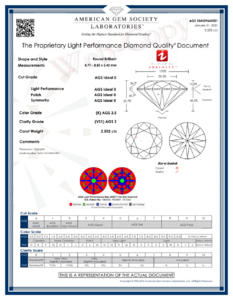
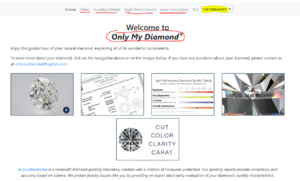
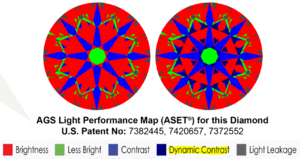
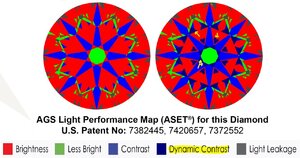
You're welcome. And thank you for thanking.Thanks for the additional info @John Pollard. As usual, good stuff.
I presume so. The word proprietary, for us, relates to the PGR (proprietary grading report) AGS makes available to established brands. We find this extremely beneficial to end-consumers because the brand ID (for us the red Infinity icon) becomes a visible extension of the grading report. In the unfortunate case of loss having that ID helps end-consumers secure another item from the brand as insurance replacement rather than something generic.I did have a few follow up questions/comments: 1. The NiceIce link I referenced had a tone that the advanced ASET imaging was something proprietary to the BGD Black cut/brand and part of what made it special. However, the AGS report provided in the linked HPD article clearly shows dual ASET images with CBI branding, which to me, indicates this report is not proprietary to any particular vendor. Correct?
No cost beyond other AGS Platinum DLP formats.2. Looking on the AGS website, I see a plethora of report options (to the point of confusing IMO). The AGS site indicates platinum as the top tier report, but does not mention advanced ASET. Is this a special request the vendor must make? Assuming so, what is the additional cost?
OMD is an added service. I don't have the fee schedule at hand but you may be able to find it online.3. I had noticed this next question awhile back. It seems that some AGS certified stones offer the Only My Diamond options, that allow you to see additional details like a video, girdle inscription, etc on the stone in question. Again, the CBI stone referenced in the HPD article is one such stone that offers this additional data. I assume this would not be vendor specific either, and just a matter of requesting the additional services and likely paying a higher price for the lab report/service being provided. Is that correct? And can you share the cost premium/difference?
The video is made when OMD is requested so it could not be provided.Is there a way to obtain this data from an older stone with a platinum report?
We did not find that to be the case. Maybe they were portents of what's has been defined as dynamic contrast by the lab. But we were unable to correlate them to actual optics.4. In regards to Dynamic Contrast, I do not feel a direct explanation was provided. It's there if you look and read carefully but I wanted to pull more attention to it. If I have interpreted correctly, the "phantoms" mentioned in the HPD article are essentially the same thing known as dynamic contrast.
The areas you indicate are not obstructed at 30 Blue. They are obstructed at 40 Blue. In terms of actual viewing 30 Blue is simulating obstructed areas at one viewing distance. 40 Blue shows areas that also become obstructed when you move the object closer. Imagine moving a diamond farther and closer. Less head-shadow when far (30B). More head-shadow when close (40B). It's showing contrast pattern dynamics. Ergo, dynamic contrast.In the second screen cap, I drew yellow arrows to more easily identify them. There are 3 main arrows they show up as. I didn't draw arrows at all them, but once you see them, you can see they repeat around the diamond.
You misspelled "carat." Plus, we don't peel. We cut and polish. Jeez.Unless someone is wearing a big blue disk on their head, one eye closed and peeling a carrot inches from there face it is totally irrelevant to the real world.
Sorry if this was asked already but what does a 40 blue image look like with a ideal cut shallower diamond and what does it look like with a less shallow diamond? In other words, how is the new image to be interpreted?
Those near the arrow-shafts are a simple table-reflection dynamic. Literally, a reflection of what the pavilion "sees" above. All else being equal, table-reflection increases as table-size and/or pavilion-depth increase.Is the irregular blues next to the arrow shafts & arrow heads caused by tilting?
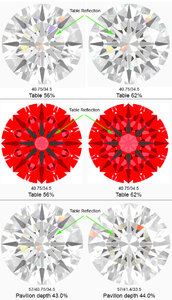
If the setup is perfectly consistent tilt will increase obstruction at one compass-point of the diamond and decrease it at the opposite compass-point.When a stone is tilted, is it similar to changing the degree of the obstruction zone as mentioned which causes these blues?
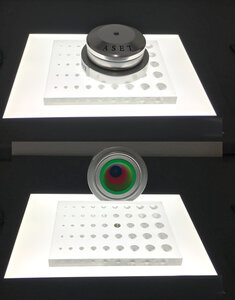
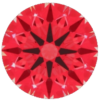 ideal-scope.com
ideal-scope.com
They don't print actual images Garry - unless you meant diamond-specific CGI. And the pavilion-rendering (aka hearts) appears on the DLP report format, which isn't being discussed in this thread.The actual images AGS print on reports is purely so they can double up and show Hearts images
AGS 40 is quite silly. It assumes a person has one eye in the midddle of their head and can focus from about 6 inches or 15cm and actually looks at diamonds from that distance.
In fact because we have 2 eyes less than 20 degree obstruction makes way more sense.
The actual images AGS print on reports is purely so they can double up and show Hearts images,
Since 90 degrees is perpendicular to the center of the hemisphere, 30 degrees of obstruction really means descending 15 degrees from 90.Question for all.
A typical handheld ASET consist of green (0-45 deg), red (45-75 deg), and blue (75-90 deg).
When you say "AGS 40", "ASET 40" or "40 deg of obstruction, does it mean blue is 50-90 deg? and red is only 45-50 deg? That's an extremely narrow range for red.
